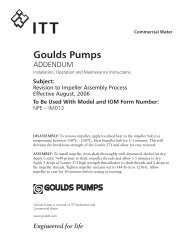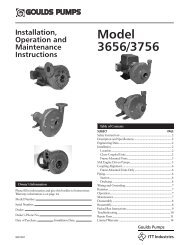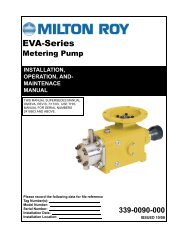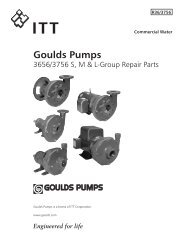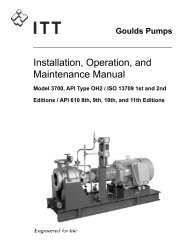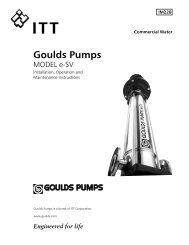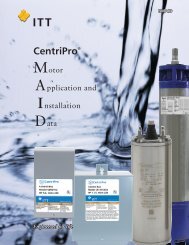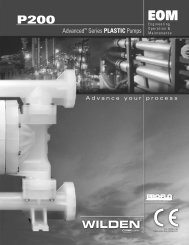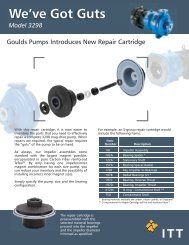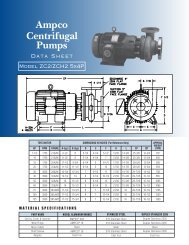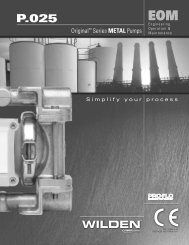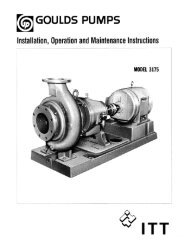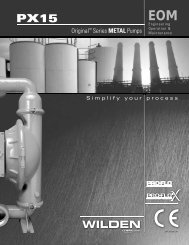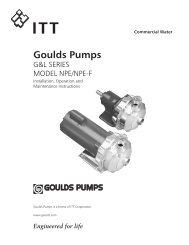Operating Instructions - Inventflow
Operating Instructions - Inventflow
Operating Instructions - Inventflow
Create successful ePaper yourself
Turn your PDF publications into a flip-book with our unique Google optimized e-Paper software.
<strong>Operating</strong><br />
Instruction<br />
Single-Acting Mechanical Seal<br />
Dokument<br />
document<br />
Blatt<br />
sheet<br />
Ausgabe<br />
issue<br />
OM.SEA.02e<br />
1 (2)<br />
A / 10.02.95<br />
1.<br />
General<br />
• Please take the appertaining drawing from<br />
respective pump data sheet.<br />
• The mechanical seal is suitable for the operating<br />
conditions indicated in the pump data sheet.<br />
Modifications are only admissible after the customer<br />
has consulted with seepex. Additionally, attention<br />
must be paid to the manufacturer’s operating<br />
manual.<br />
2.<br />
Safety<br />
Any mode of operation impairing the operating safety<br />
of the mechanical seal has to be avoided.<br />
The operator is advised to consider the possible<br />
effects on the environment which could be caused by<br />
a defective mechanical seal and what additional<br />
measures must be taken to protect the environment<br />
and the public.<br />
The pump must be mounted and operated in such<br />
a way that operation with a defective mechanical seal<br />
will not result in injury or harm to the public and that<br />
any leakage can be safely and properly dealt with.<br />
Mechanical seals are often used to seal hazardous<br />
material (chemicals, drugs, etc.). It is essential that<br />
rules pertaining to the handling of hazardous materials<br />
are adhered to.<br />
Modifications effected by the customer himself and<br />
changes influencing the safety of the mechanical seal<br />
are not allowed.<br />
3.<br />
Emissions<br />
A mechanical seal is a dynamic seal and leakage is<br />
unavoidable.<br />
ATTENTION<br />
Components that may contact leakage must be<br />
resistant to corrosion or be protected accordingly.<br />
Mechanical seal leakage must be drained in a safe<br />
and proper manner.<br />
4.<br />
Flushing or circulation of single-acting mechanical<br />
seals<br />
Single-acting mechanical seals contacting the conveying<br />
liquid require no additional flushing or a<br />
circulation pipe because sufficient flushing and heat<br />
exchange occurs around the seal due to the conveying<br />
liquid.<br />
However, in particular cases, a direct flushing pipe can<br />
be installed into the flushing connection on the<br />
mechanical seal housing.<br />
5.<br />
Commissioning<br />
Regardless of the pump's operating status, the conveying<br />
medium to be sealed must always be in liquid<br />
form at the mechanical seal. This particularly applies<br />
to the pump's commissioning and its placing out of<br />
service.<br />
6.<br />
Maintenance<br />
When operating the pump according to the instructions,<br />
no maintenance is required.<br />
7.<br />
Disassembly / Reassembly<br />
7.1<br />
Disassembly<br />
- Remove flushing connections at shaft seal housing<br />
(SAE).<br />
- Lift / displace splash ring (310) and eject plug-in<br />
shaft pin (309) horizontally.<br />
- Withdraw rotating unit (RTE) together with shaft seal<br />
parallel from output shaft of drive and avoid<br />
chocking.<br />
- Clean plug-in shaft (307) and remove burrs etc.,<br />
which may damage sealing elements. Moisten plugin<br />
shaft (307) with slip additive (diluted fluid soap).<br />
- Loosen axial safety device of mechanical seal (330<br />
or 372) and withdraw mechanical seal (330) from<br />
plug-in shaft (307).<br />
- Remove mechanical seal housing (333) from lantern<br />
(200).<br />
- Press counter-ring of mechanical seal with o-ring out<br />
of mechanical seal housing (333).



